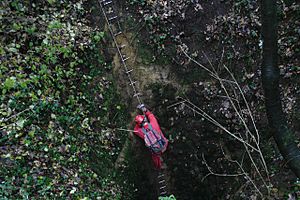Hangman's Wood and Deneholes facts for kids
| Site of Special Scientific Interest | |
 |
|
| Area of Search | Essex |
|---|---|
| Coordinates | 51°29′23″N 0°20′52″E / 51.4896°N 0.3477°E |
| Interest | Biological |
| Area | 3.0 hectares |
| Notification | 1986 |
| Location map | Magic Map |
Hangman's Wood and Deneholes is a special place in Little Thurrock, Essex. It's a 3-hectare area of woodland that's protected for its amazing nature. This area is called a Site of Special Scientific Interest (SSSI) because of its unique plants and animals. It's also known for its ancient trees and underground caves called deneholes. These deneholes were dug a long time ago. They are now very important homes for bats!
Contents
Hangman's Wood and Deneholes
What are Deneholes?
Deneholes are deep, bell-shaped pits dug into the ground. People made them a long time ago, probably in the Middle Ages. They were dug to mine for chalk or flint. The chalk was used to make soil better for farming. Flint was used for tools or building.
The deneholes in Hangman's Wood are very old. They are so important that they are a Scheduled monument. This means they are protected by law. There used to be more than 70 deneholes in the wood. Today, most of them look like shallow dips in the ground.
Home to Bats
The deneholes in Hangman's Wood are super important for bats. They are the best underground places for bats to hibernate in all of Essex. Hibernating means the bats sleep through the winter. They need a quiet, cool, and stable place to do this.
Three different types of bats use these deneholes:
The old oak trees in the wood are also important. They provide food for the bats when they are not hibernating. This makes the wood a perfect home for them. Usually, you can't go into the deneholes. This helps keep the bats safe and undisturbed.
A Bit of History
The name Hangman's Wood has been around for a long time. It was first written down on a map in the mid-1600s. The trees in the wood are also very old. You can find oak, ash, sycamore, and wild cherry trees growing there.
People have been curious about the deneholes for a long time. They were explored by a group called the Essex Field Club in the late 1800s. Some people even called them "Cunobeline's gold mines." This was a fun, old name for them.
Exploring the Area
There is a path that goes through Hangman's Wood. It connects to another area called Terrel's Heath. This path is part of a very old route. It used to go all the way from Coalhouse Point in East Tilbury to a bridge near Aveley. It's a great way to explore the history and nature of the area.


